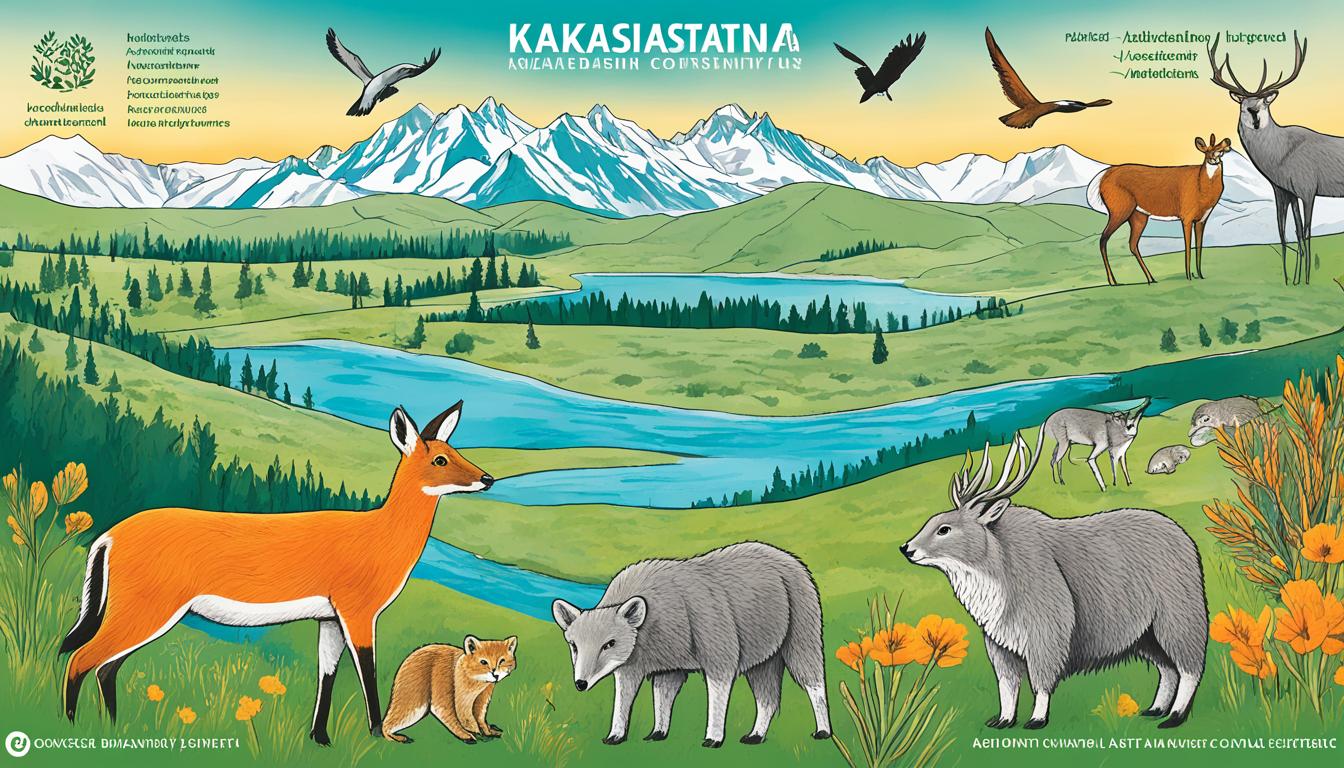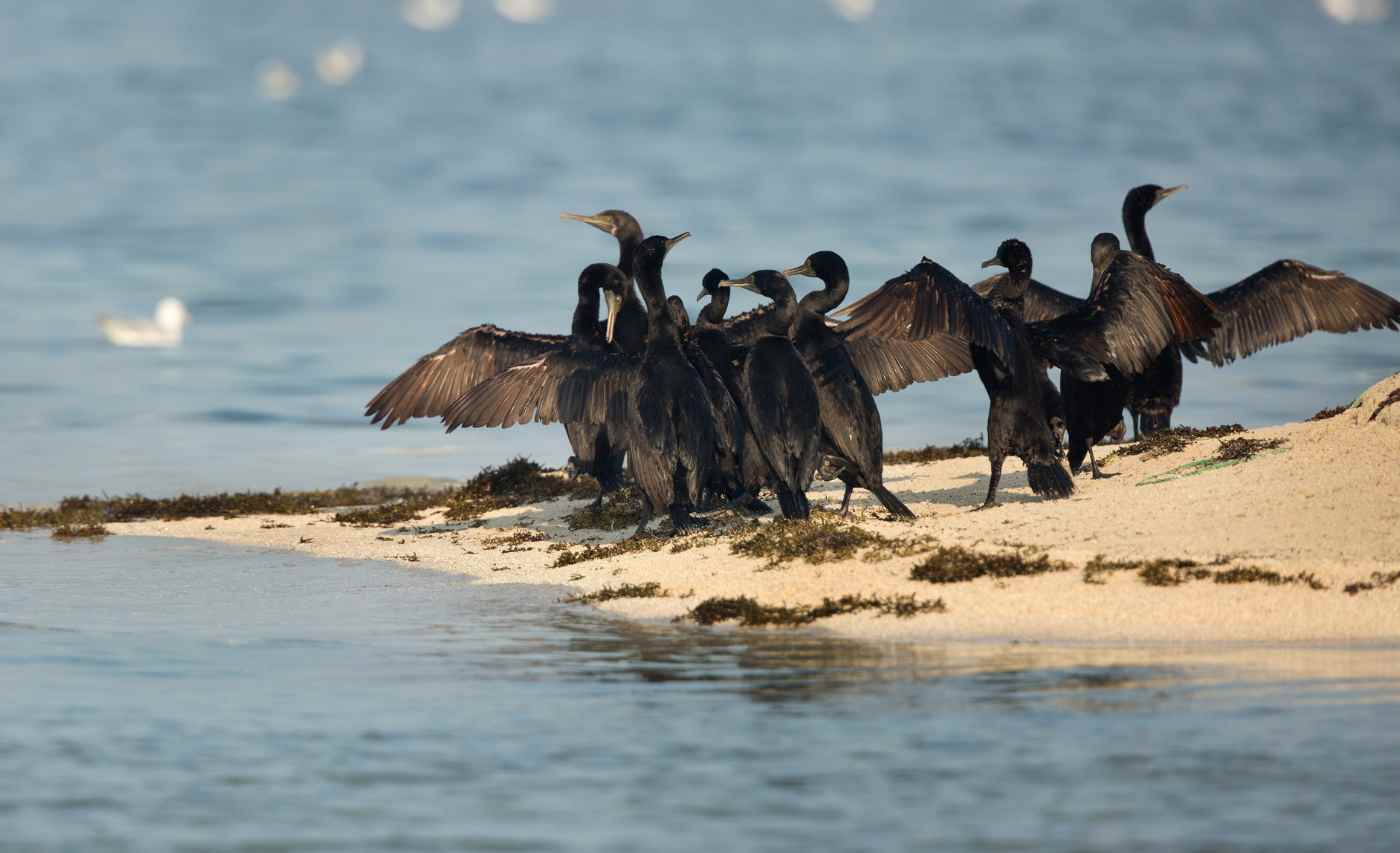Kenya Biodiversity: Animal and Plant Species and What Is Under Threat
Kenya is renowned for its rich biodiversity, boasting a diverse range of animal and plant species. From the majestic African elephant to the vibrant native flora, the country’s ecosystems are teeming with life. However, this biodiversity faces numerous threats that jeopardize the delicate balance of nature. Understanding these threats is crucial for devising effective conservation strategies and safeguarding Kenya’s precious ecosystems.
Key Takeaways
- Kenya is home to a wide variety of animal and plant species, contributing to its vibrant biodiversity.
- Threats to biodiversity include habitat loss, overexploitation, and cultural attitudes.
- Conservation efforts and initiatives such as forest reservations and biodiversity mainstreaming aim to protect Kenya’s biodiversity.
- Lack of a coherent integrated conservation policy, technical expertise, and funding pose challenges to biodiversity conservation.
- Sustainable practices and increased awareness are essential for ensuring the survival of Kenya’s unique ecosystems.
Key Policies and Governance Approach
Kenya has established a comprehensive framework of national policies, legislation, regulations, and guidelines to govern the conservation and management of its rich biodiversity. These legal instruments play a critical role in safeguarding the country’s natural heritage and ensuring sustainable practices for future generations. Key among these policies are the National Wildlife Conservation Strategy, the National Wildlife Policy, the Wildlife Conservation and Management Act, and the Forest Conservation and Management Act.
By enacting these national policies, Kenya has laid a solid foundation for biodiversity conservation and management. These policies provide a clear roadmap and set standards for protecting and preserving the diverse flora and fauna that flourish within its borders. Moreover, Kenya has demonstrated its commitment to global biodiversity initiatives by signing and ratifying the Convention on Biological Diversity, aligning itself with international efforts to safeguard the planet’s natural resources.
The National Environment Management Authority (NEMA) plays a crucial role in coordinating and establishing a robust legal and institutional framework for biodiversity management and conservation in Kenya. NEMA’s efforts ensure the effective implementation of national policies, maintain regulatory compliance, and provide oversight in matters of environmental governance.
Despite the existence of these policies, Kenya faces significant challenges in implementing a coherent integrated conservation policy. Factors such as overexploitation, habitat loss, and cultural attitudes continue to contribute to biodiversity loss. It is imperative that Kenya focuses on strengthening governance mechanisms, addressing regulatory gaps, and enhancing enforcement to counteract these threats effectively.
Effective governance, backed by national policies, helps create a conducive environment for conservation efforts and enhances collaboration among stakeholders, including government agencies, communities, and NGOs. The integration of biodiversity conservation and management into national policies and development plans is crucial to ensuring a sustainable future for Kenya and safeguarding its unparalleled biodiversity for generations to come.
Kenya’s commitment to sustainable development and biodiversity conservation is evident in its efforts to establish comprehensive national policies and strengthen governance mechanisms. These initiatives lay the foundation for safeguarding the country’s invaluable natural heritage and promoting sustainable practices.
| Policies and Legislation | Description |
|---|---|
| National Wildlife Conservation Strategy | The strategy provides a holistic framework for conserving wildlife and their habitats in Kenya. |
| National Wildlife Policy | This policy outlines guidelines for sustainable wildlife management, focusing on conservation, research, and tourism. |
| Wildlife Conservation and Management Act | The act establishes regulations for the conservation, management, and sustainable utilization of wildlife resources in Kenya. |
| Forest Conservation and Management Act | This act regulates the conservation and sustainable use of forest resources, ensuring the protection of biodiversity in forested areas. |
Successes and Remaining Challenges
Responsibility for biodiversity conservation in Kenya is shared among various institutions, including national and county governments, private landowners, local communities, and NGOs. Despite these collaborative efforts, there are still challenges that need to be addressed to ensure the long-term preservation of biodiversity.
One significant challenge is the lack of a coherent integrated conservation policy that can harmonize the various legislation and policies across different sectors. This lack of unity often leads to conflicting approaches and hinders effective biodiversity conservation strategies.
Overexploitation and habitat loss are also major contributors to biodiversity loss in Kenya. The unsustainable use of natural resources and the destruction of habitats threaten the survival of numerous animal and plant species. Additionally, cultural attitudes towards nature and species can fuel harmful practices that further degrade biodiversity.
Another obstacle is the shortage of technical expertise and resources. Adequate knowledge and skills are essential for implementing effective conservation measures and managing biodiversity sustainably. (https://tesseraonlaketravis.com/) Furthermore, limited funding poses a significant challenge to biodiversity conservation efforts in Kenya.
Despite these challenges, there have been notable successes in biodiversity conservation. The reservation of forest blocks has been a positive step towards protecting vital habitats. Additionally, initiatives like the BIODEV2030 aim to mainstream biodiversity into key economic sectors, promoting sustainable practices and ensuring the long-term well-being of both people and nature.
Forest Blocks Reservation in Kenya:
| Forest Name | Location |
|---|---|
| Boni Lungi Forest | Coastal region |
| Kibwezi dry forest | Eastern region |
Addressing the challenges of biodiversity conservation in Kenya requires a multi-faceted approach. It involves strengthening policy coherence, promoting sustainable land use practices, building technical expertise, and securing adequate funding. Furthermore, efforts to mainstream biodiversity into various sectors of the economy can contribute to a more holistic and effective conservation strategy.
By overcoming these challenges and building upon the successes achieved so far, Kenya can continue to conserve its rich biodiversity for future generations to enjoy and benefit from.
Initiatives and Development Plans
Kenya is dedicated to implementing the National Biodiversity Strategy and Action Plan (NBSAP) to ensure the conservation of its rich biodiversity. The country has devised a range of initiatives and development plans that focus on promoting biodiversity conservation and sustainable practices.
One of the key initiatives is the BIODEV2030 program. This groundbreaking initiative aims to mainstream biodiversity into various economic sectors, foster the growth of sustainable and resilient economies, and reverse the alarming decline in biodiversity. By integrating biodiversity considerations into industries such as agriculture, tourism, and energy, Kenya aims to strike a balance between economic development and environmental preservation.
“BIODEV2030 is a bold and transformative initiative that acknowledges the importance of biodiversity in achieving sustainable development. By infusing biodiversity considerations into economic sectors, we can create a harmonious and prosperous future for both people and nature.” – Dr. Jane, Minister for Environment and Natural Resources
To safeguard biodiversity, the government has also implemented forest reservation measures. Notable forest blocks, such as the Boni Lungi Forest and the Kibwezi dry forest, have been set aside to protect critical ecosystems and habitats. These reservations provide vital refuges for a wide array of plant and animal species, ensuring their survival and supporting the overall health of the environment.
These initiatives and development plans reflect Kenya’s commitment to increasing forest cover and enhancing habitat quality for land-based biodiversity. Through sustainable practices and strategic conservation efforts, Kenya aims to preserve its natural heritage for future generations.

Kenya’s Reserved Forest Blocks
| Forest Block | Location |
|---|---|
| Boni Lungi Forest | Eastern Kenya |
| Kibwezi dry forest | Southeastern Kenya |
Goals and Ambitions
In Kenya, one of the major goals is to increase the country’s forest cover to 10%, thereby improving the habitat for land-based biodiversity. This ambitious target is in line with the National Biodiversity Strategy and Action Plan, which aims to preserve and harness the genetic resources and biological diversity of Kenya’s ecosystems. By expanding forest cover, not only will it provide a better habitat for various species, but it will also contribute to the sustainable livelihoods of Kenyan communities.
Increasing forest cover is vital for the conservation of land-based biodiversity and the overall health of the ecosystem. Forests provide crucial habitats for a diverse range of plant and animal species, supporting complex ecological relationships and fostering biodiversity. By enhancing habitat quality and connectivity, we can promote species resilience and ensure the inter- and intra-generational sustainable use of natural resources and services.
The Kenyan government has taken significant measures to achieve these goals, including the reservation of forest blocks and the implementation of sustainable practices. Forest reservations protect critical areas of biodiversity and help safeguard the unique species found within them. By designating these areas as protected, it ensures that their natural resources and ecosystems remain preserved for future generations to enjoy.
In addition, sustainable practices such as responsible logging and reforestation initiatives contribute to the improvement of habitat quality and the restoration of degraded areas. These efforts ensure that the benefits derived from forests, such as timber, non-timber forest products, and ecosystem services, can be realized without compromising the well-being of the environment and future biodiversity.
Overall, the goals and ambitions of increasing forest cover and improving habitat for land-based biodiversity in Kenya are crucial for the long-term conservation and preservation of the nation’s natural heritage. By prioritizing these objectives and implementing sustainable practices, Kenya can continue to protect its incredible biodiversity and contribute to the global effort of ensuring a sustainable future for all.
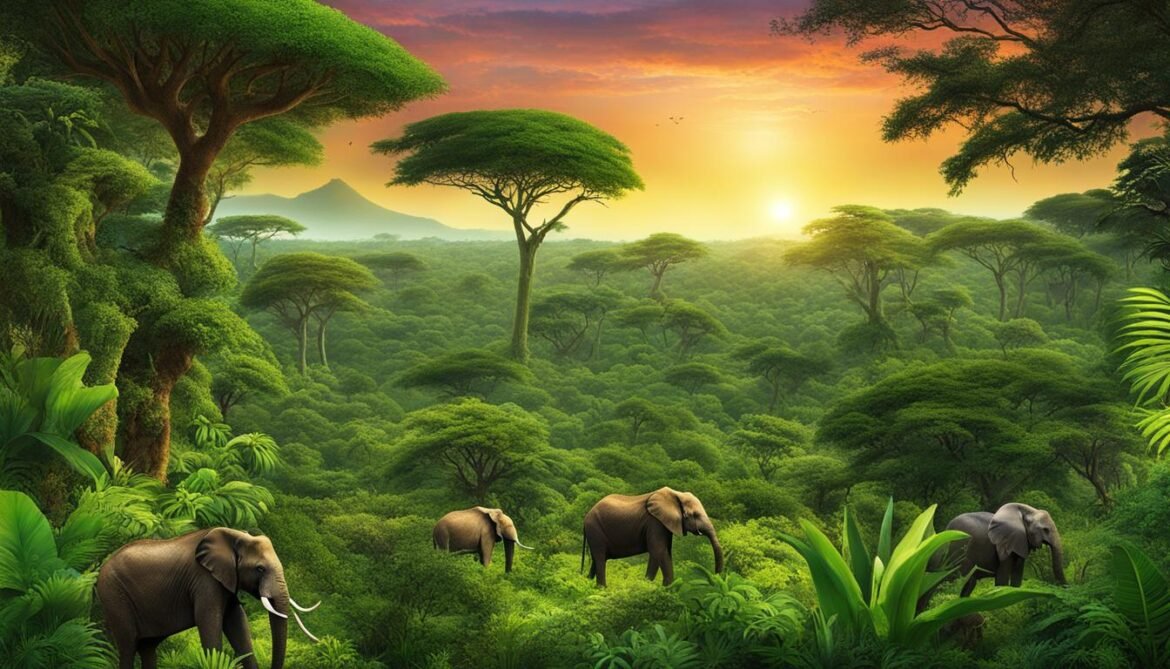
Endangered Plant Species in Kenya
Kenya is home to a diverse range of plant species, but unfortunately, many of them are facing the threat of extinction. Factors such as overexploitation and deforestation have placed several plant species in jeopardy.
Among the endangered plant species in Kenya are:
- Bauhinia mombassae
- Brucea macrocarpa
- Voi cycad (Encephalartos kisambo)
- East African sandalwood (Osyris lanceolata)
- Red stinkwood (Prunus africana)
- Meru oak (Vitex keniensis)
- Camphor (Ocotea kenyensis)
- Parasol tree (Polyscias kikuyuensis)
- Rat aloe (Aloe ballyi)
- Tana river poplar (Populus ilicifolia)
- Combretum tenuipetiolatum
- Euphorbia tanaensis
- African Olive (Olea europea ssp africana)
- Knobwood (Zanthoxylum chalybeum)
These plant species are under threat due to various activities, including agricultural expansion, overexploitation for timber and medicine, and habitat loss. Efforts must be made to protect and preserve these species to maintain the rich biodiversity of Kenya.
| Endangered Plant Species | Threats |
|---|---|
| Bauhinia mombassae | Overexploitation, habitat loss |
| Brucea macrocarpa | Deforestation, habitat loss |
| Voi cycad (Encephalartos kisambo) | Agricultural expansion, habitat loss |
| East African sandalwood (Osyris lanceolata) | Overexploitation, deforestation |
| Red stinkwood (Prunus africana) | Overexploitation, habitat loss |
| Meru oak (Vitex keniensis) | Deforestation, agricultural expansion |
| Camphor (Ocotea kenyensis) | Overexploitation, habitat loss |
| Parasol tree (Polyscias kikuyuensis) | Deforestation, habitat loss |
| Rat aloe (Aloe ballyi) | Agricultural expansion, habitat loss |
| Tana river poplar (Populus ilicifolia) | Deforestation, habitat loss |
| Combretum tenuipetiolatum | Overexploitation, deforestation |
| Euphorbia tanaensis | Agricultural expansion, habitat loss |
| African Olive (Olea europea ssp africana) | Overexploitation, habitat loss |
| Knobwood (Zanthoxylum chalybeum) | Deforestation, habitat loss |
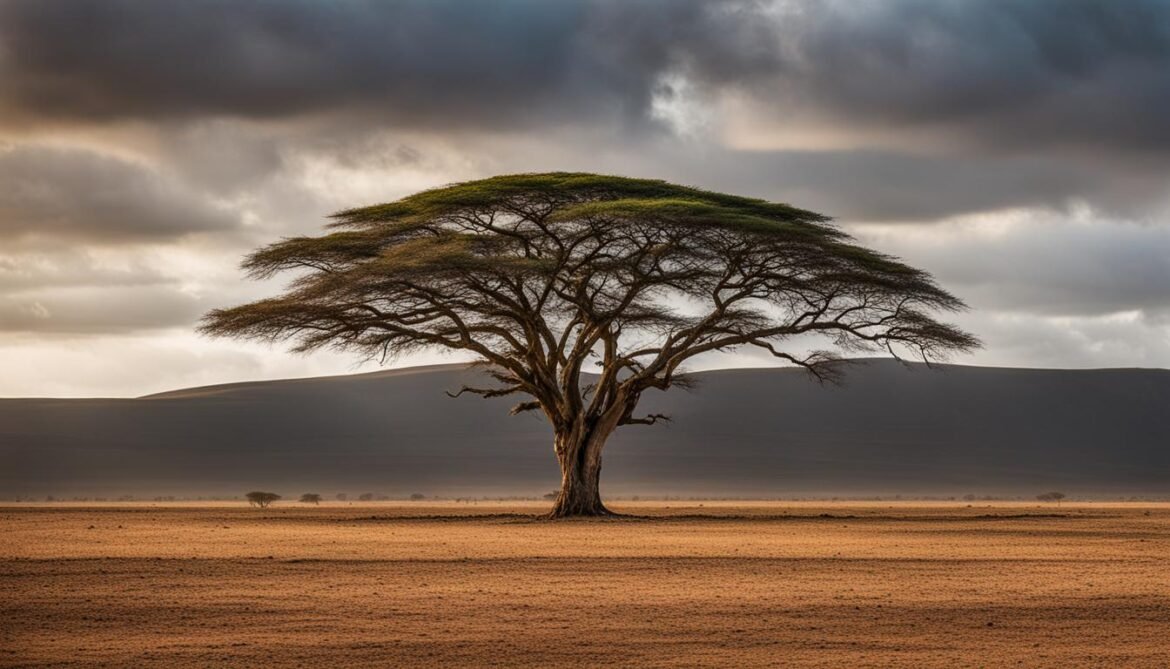
Threatened Mammal Species in Kenya
Kenya is home to a diverse range of mammal species, many of which are currently under threat. These majestic creatures play a vital role in the country’s biodiversity and ecosystem stability.
Among the threatened mammal species in Kenya are:
- Aders’ duiker
- Black rhinoceros
- Hirola
- Eastern red colobus
- Tana crested mangabey
- Roan antelope
- Sable antelope
- African elephant
- African lion
- Cheetah
- Striped hyaena
- Sitatunga
- Leopard
- White rhino
- Grevy’s zebra
- African wild dog
- Giant thicket rat
- Barbour’s vlei rat
- Mount elgon vlei rat
- Golden-rumped elephant shrew
- Eastern bongo
- Lelwel hartebeest
- Rothschild’s giraffe
- Coalfish whale
- Blue whale
These mammal species face various threats, including habitat loss, poaching, and human-wildlife conflicts. Habitat loss is particularly concerning as it disrupts the natural environment and limits the resources available for these species to thrive.
Conservation efforts in Kenya are focused on protecting these threatened mammal species and their habitats. The Wildlife Conservation and Management Act has been implemented to enforce regulations against illegal hunting and trade. Additionally, measures have been taken to increase the number of protected areas to provide safe havens for these vulnerable animals.
| Mammal Species | Threats |
|---|---|
| Aders’ duiker | Habitat loss, poaching |
| Black rhinoceros | Habitat loss, poaching |
| Hirola | Habitat loss, poaching |
The conservation efforts in Kenya are crucial for the long-term survival of these mammal species and the overall balance of the ecosystem. Protecting their habitats, raising awareness about their conservation status, and enforcing strict regulations against poaching are vital steps towards ensuring a future where these magnificent creatures can thrive.
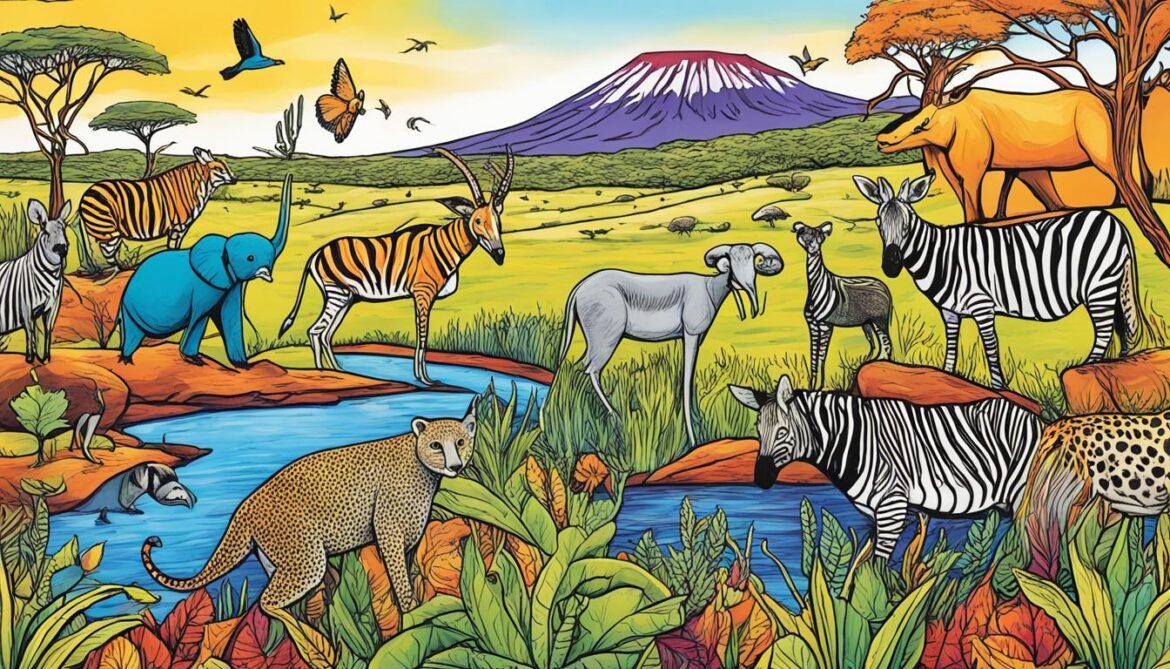
Amphibians and Reptiles at Risk
Kenya is home to a variety of endangered amphibians and reptiles that are facing significant threats to their survival. These species play a vital role in maintaining the biodiversity of the region and their loss would have far-reaching consequences. Efforts are being made to protect these unique creatures through research, conservation programs, and awareness campaigns.
Some of the endangered amphibians and reptiles in Kenya include Du toit’s torrent frog, Shimba hills banana frog, Shimba hills reed frog, Forest frog, Hawksbill turtle, Green sea turtle, Olive ridley, Rock python, and Montane dancing-jewel. These species are facing various challenges, such as habitat degradation, land clearance, and pollution.
Habitat degradation poses a significant threat to these amphibians and reptiles. As urbanization and human activities expand, natural habitats are being destroyed, leaving the species without suitable places to live and breed. Land clearance for agriculture, infrastructure development, and logging further exacerbate these issues.
Pollution, especially water pollution, is another major threat to these species. Contamination of water bodies, including rivers, lakes, and wetlands, can have detrimental effects on the health and survival of amphibians and reptiles. Pollution from industrial waste, agricultural runoff, and improper waste disposal can disrupt their reproductive cycles and lead to population declines.
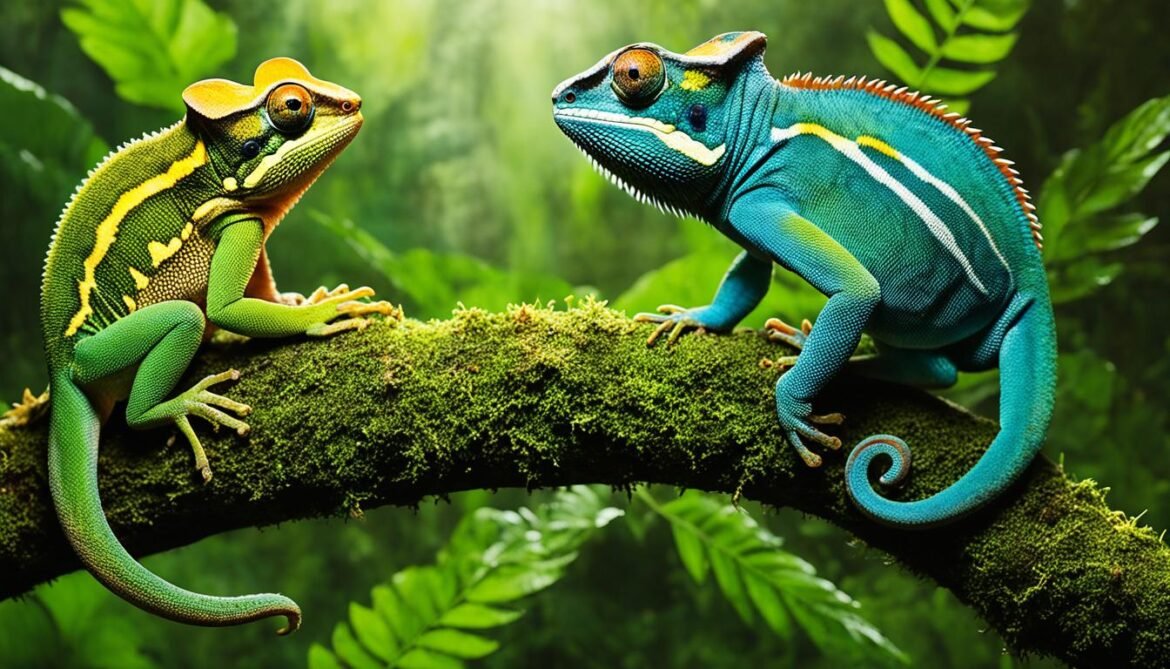
Conservation programs are actively working to protect these endangered species. Research plays a crucial role in understanding their ecology, behavior, and conservation needs. Conservation organizations collaborate with local communities and government agencies to implement measures aimed at habitat restoration, pollution control, and sustainable land use practices.
Education and awareness campaigns are vital for fostering a deeper appreciation and understanding of the importance of preserving these amphibians and reptiles. By raising awareness among the public and encouraging responsible environmental practices, we can help to safeguard their habitats for future generations.
Endangered Amphibians and Reptiles in Kenya
| Species | Status | Threats |
|---|---|---|
| Du toit’s torrent frog | Endangered | Habitat degradation, pollution |
| Shimba hills banana frog | Endangered | Habitat degradation, land clearance |
| Shimba hills reed frog | Endangered | Habitat degradation, pollution |
| Forest frog | Endangered | Habitat degradation, land clearance |
| Hawksbill turtle | Endangered | Habitat degradation, pollution |
| Green sea turtle | Endangered | Habitat degradation, pollution |
| Olive ridley | Endangered | Habitat degradation, pollution |
| Rock python | Endangered | Habitat degradation, land clearance |
| Montane dancing-jewel | Endangered | Habitat degradation, land clearance |
Fish Threatened with Extinction in Kenya
Fish species in Kenya are facing the alarming risk of extinction due to several factors, including overfishing, eutrophication, and the introduction of invasive species like the Nile Perch. These threats have put significant pressure on the delicate balance of aquatic ecosystems in Kenya’s waters.
Among the endangered fish species in Kenya are the Singidia tilapia, Lake Chala tilapia, Jipe tilapia, Victoria tilapia, Rainbow sheller, Lake Victoria deepwater catfish, Montane dancing-jewel, Magadi tilapia, Giant wrasse, and Victoria stonebasher. These species play a vital role in maintaining the health and biodiversity of the aquatic ecosystems, offering numerous benefits to both the environment and local communities.
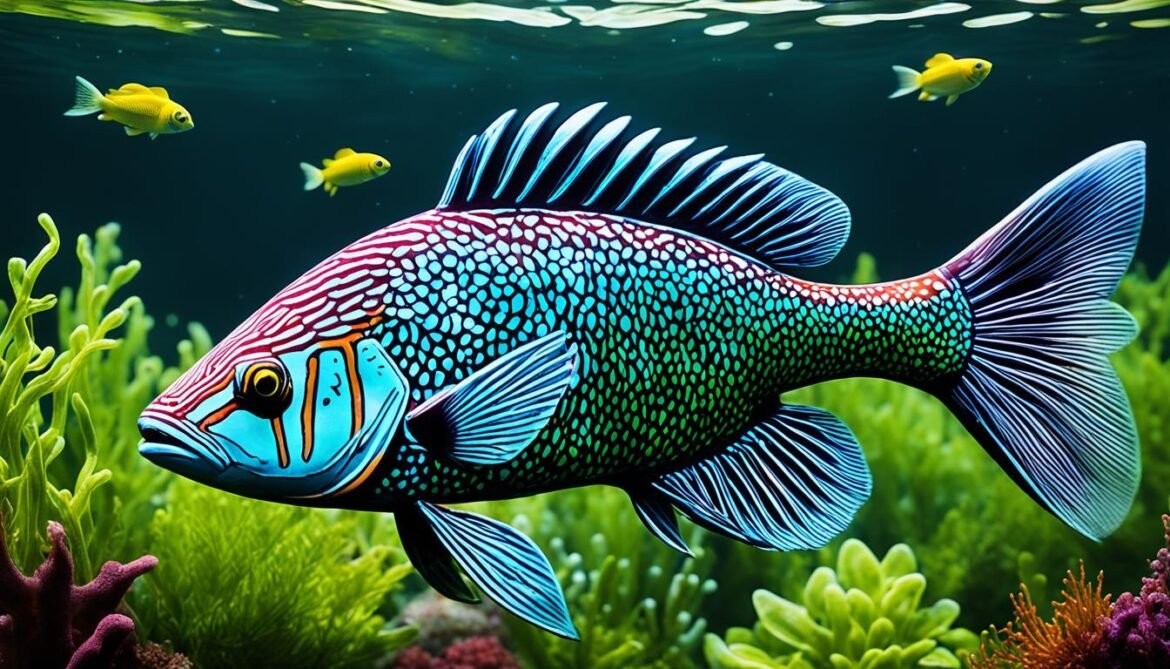
Conservation efforts focus on mitigating the threats to these fish species and promoting sustainable fishing practices. Overfishing is a significant concern, as it disrupts the natural reproductive cycles of fish populations and depletes their numbers. Introducing regulations and implementing responsible fishing practices can help alleviate the pressure on these vulnerable species while ensuring the sustainable livelihoods of fishing communities.
Invasive species, such as the Nile Perch, have had a devastating impact on native fish populations in Kenya’s waters. These invaders outcompete native species for resources, disrupt natural habitats, and ultimately push indigenous fish towards extinction. Controlling the spread of invasive species and implementing measures to restore and protect the habitats of native fish are crucial steps in safeguarding their survival.
Protecting endangered fish species in Kenya is not only essential for preserving the delicate balance of aquatic ecosystems but also for the sustainable future of both the environment and local communities that rely on these fish for food and livelihoods.
By enhancing conservation measures, raising awareness about the importance of preserving fish species, and empowering local communities to engage in sustainable fishing practices, it is possible to mitigate the threats imposed on the endangered fish species in Kenya. Through collective efforts, we can secure a healthier and more sustainable future for these irreplaceable aquatic ecosystems.
Endangered Fish Species in Kenya
| Fish Species | Threats |
|---|---|
| Singidia tilapia | Overfishing, habitat loss |
| Lake Chala tilapia | Overfishing, invasive species |
| Jipe tilapia | Overfishing, invasive species |
| Victoria tilapia | Overfishing, habitat degradation |
| Rainbow sheller | Overfishing, habitat loss |
| Lake Victoria deepwater catfish | Habitat loss, invasive species |
| Montane dancing-jewel | Habitat degradation, invasive species |
| Magadi tilapia | Overfishing, invasive species |
| Giant wrasse | Overfishing, habitat degradation |
| Victoria stonebasher | Habitat loss, invasive species |
Importance of Bird Migration and Feeding Habits of Lions and Leopards
Bird migration is a fascinating phenomenon that adds to the rich biodiversity of Kenya. Every year, many species travel to the country from different parts of the world, making it a key destination for birdwatchers and nature enthusiasts. These migratory birds play a crucial role in pollination and seed dispersal, contributing to the overall health of ecosystems.
Lions, as apex predators, are an essential part of the ecosystem in Kenya. Their feeding habits primarily consist of herbivores, such as zebras and antelopes. By consuming these herbivores, lions help control their population and prevent overgrazing in certain areas. This ensures a balance in the vegetation and maintains the health of the entire ecosystem.
Leopards, on the other hand, are opportunistic hunters with a diverse diet. They are known to feed on a variety of prey, including small mammals, birds, and even fish. Their ability to adapt their feeding habits based on availability allows them to occupy a wide range of habitats. This flexibility makes leopards important for maintaining biodiversity as they contribute to the regulation of prey populations.
Understanding the feeding habits of these predators is crucial for effective conservation. By protecting their habitats and ensuring the survival of their prey species, we can help maintain the delicate balance of ecosystems in Kenya. It is our responsibility to preserve the biodiversity that makes this country so unique and to ensure that future generations can continue to marvel at the wonders of bird migration and the majestic nature of lions and leopards.
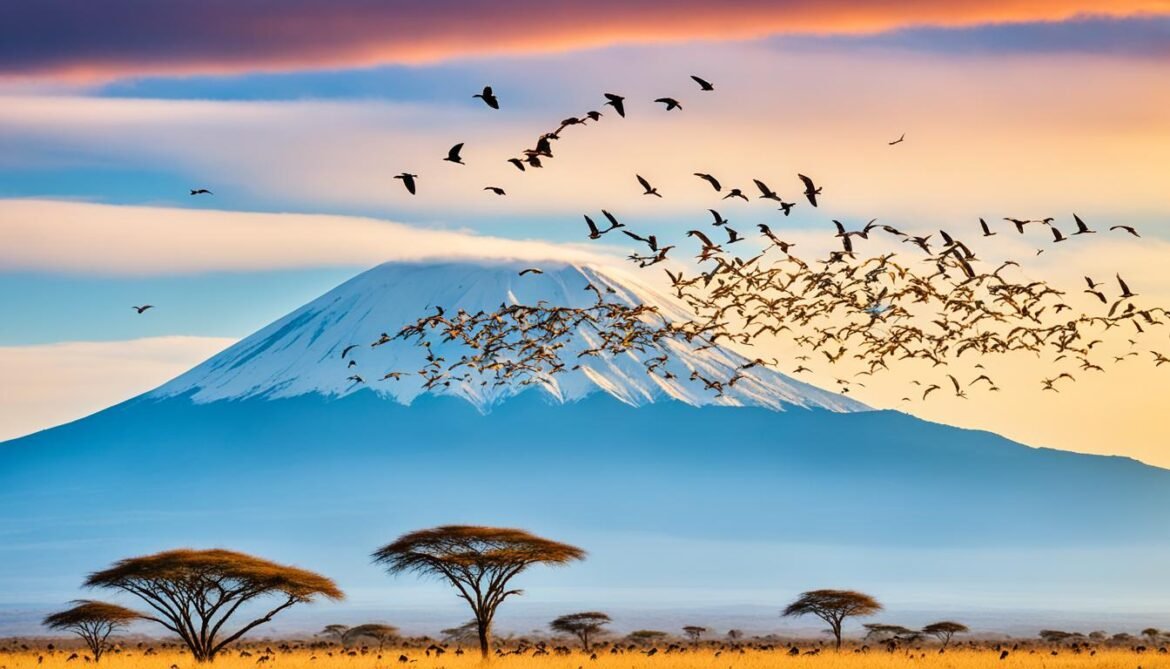
Examples of Bird Species that Migrate to Kenya
| Bird Species | Migratory Origin |
|---|---|
| African Paradise Flycatcher | Europe and Asia |
| Cuckoo | Europe and Asia |
| Barn Swallow | Europe and Asia |
| Rufous-bellied Heron | Africa and Madagascar |
| Yellow Wagtail | Europe and Asia |
| Lesser Flamingo | Various regions in Africa |
| Grey-capped Warbler | Africa and Asia |
Conclusion
Kenya boasts a remarkable diversity of animal and plant species, but unfortunately, these precious resources are facing significant threats. Factors such as habitat loss, overexploitation, and cultural attitudes are endangering the biodiversity that makes Kenya so unique.
Fortunately, the country has made substantial efforts to protect and conserve its biodiversity. Through policies, initiatives, and development plans, Kenya is working towards safeguarding its natural heritage. Forest reservations, biodiversity mainstreaming, and sustainable practices are some of the strategies being implemented to enhance biodiversity conservation in the country.
Despite these achievements, numerous challenges remain. The lack of a unified conservation policy and the need for increased technical expertise and funding pose significant obstacles. However, it is crucial that conservation efforts continue to ensure the preservation of Kenya’s rich biodiversity for both present and future generations. By prioritizing sustainable practices and continuing to invest in conservation efforts, we can secure a thriving environment that benefits both wildlife and people.




